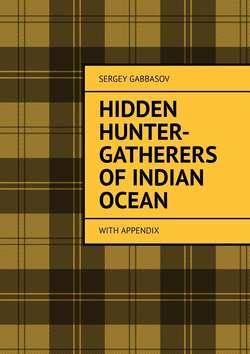Читать книгу Hidden Hunter-Gatherers of Indian Ocean. with appendix - Sergey Marlenovich Gabbasov - Страница 2
FOREWORD
ОглавлениеWhom we imagine when talk about hunter-gatherer? A dark-skin small man almost without any clothes, with a spear or bow and arrows. His family live in a deep rainforest or in an endless savannah, they make a fire by drilling, live a nomadic life and know nothing about agriculture and pastoralism. It is enough for a standard person who is ready to forget everything that doesn’t concern with his everyday job. But if you read this book – you are not such a person.
We also know that their lifestyle is the most ancient and 90% of all human beings who ever lived on our beautiful planet (~80 000 000 000 individuals) were hunter-gatherers (Lee & DeVore 1968). It is the most effective, most harmonized and ecological way of connection between humans as biological specie and all the nature itself. Living as a hunter and gatherer, human don’t opposite themselves to the nature by a constant fighting in a constant process of production food by keeping cattle (making pastures, killing predators, overgrazing) or agriculture (slash-and-burn cultivation, deforestation, invasion of plants). Every anthropologist who is interested in hunter-gatherers knows such iconic peoples as Hadza of Tanzania, Baka of South-East Cameroon and Mbuti of North-East DRC, Bushmen of South Africa and Kubu of Sumatra, about Andamanese and Indigenous Australians.
But at the same time there are several peoples who are always very far from the mainstream anthropology. They seem to be classical agriculturalists who live normal sedentary life.
Sometimes it is almost impossible to be sure about some concrete ethnic group – are they real hunters and gatherers or just have some elements of occasional foraging (and such elements may be non-indigenous). People of Zanzibar archipelago go to forage wild fruits and berries, fallen coconuts and many kinds of seafood at a low-tide at a regular basis – the resources of islands and surrounding waters are limited and strongly depend on the weather season and ocean streams. But at the same time most of them involved in farming, fishing and trade – traditional occupations of this archipelago for many centuries. Still it is hard to classify such peoples as Veddahs of Sri Lanka and Mikea of Madagascar. Meanwhile such peoples as Birhor of Central India and Chepang of Central Nepal aren’t connected with living traditions of hunting and gathering. But exactly these peoples go to forage and even sometimes hunt small game more often than such “classical” hunter-gatherers as Veddahs. There are extremely few studies about the origins of the Mlabri and about their hunting and gathering traditions. Less can be found about Ahikuntikas people (it is good if you just heard about them).
By writing of this book I tried to use a powerful basement of previous studies since XIX century till modern days and build a little (but comfortable I suppose) house, entering which a wanderer can find some answers. In this book we will try to make a short overlook on some of such people who live around Indian Ocean – from Northern Thailand to South Madagascar, from Sri Lanka to Himalaya. We will point islands and coasts, mountains and savannahs. And everywhere we will meet them – hunter-gatherers who remain hidden. So, let our journey begins!
I want to thank those people who always help me on the path of my life – my beloved wife Elena Erkina, my darling mother Tatiana Khromova and my dearest father Marlen Gabbasov. Thank you for everything!
Sergey Gabbasov
